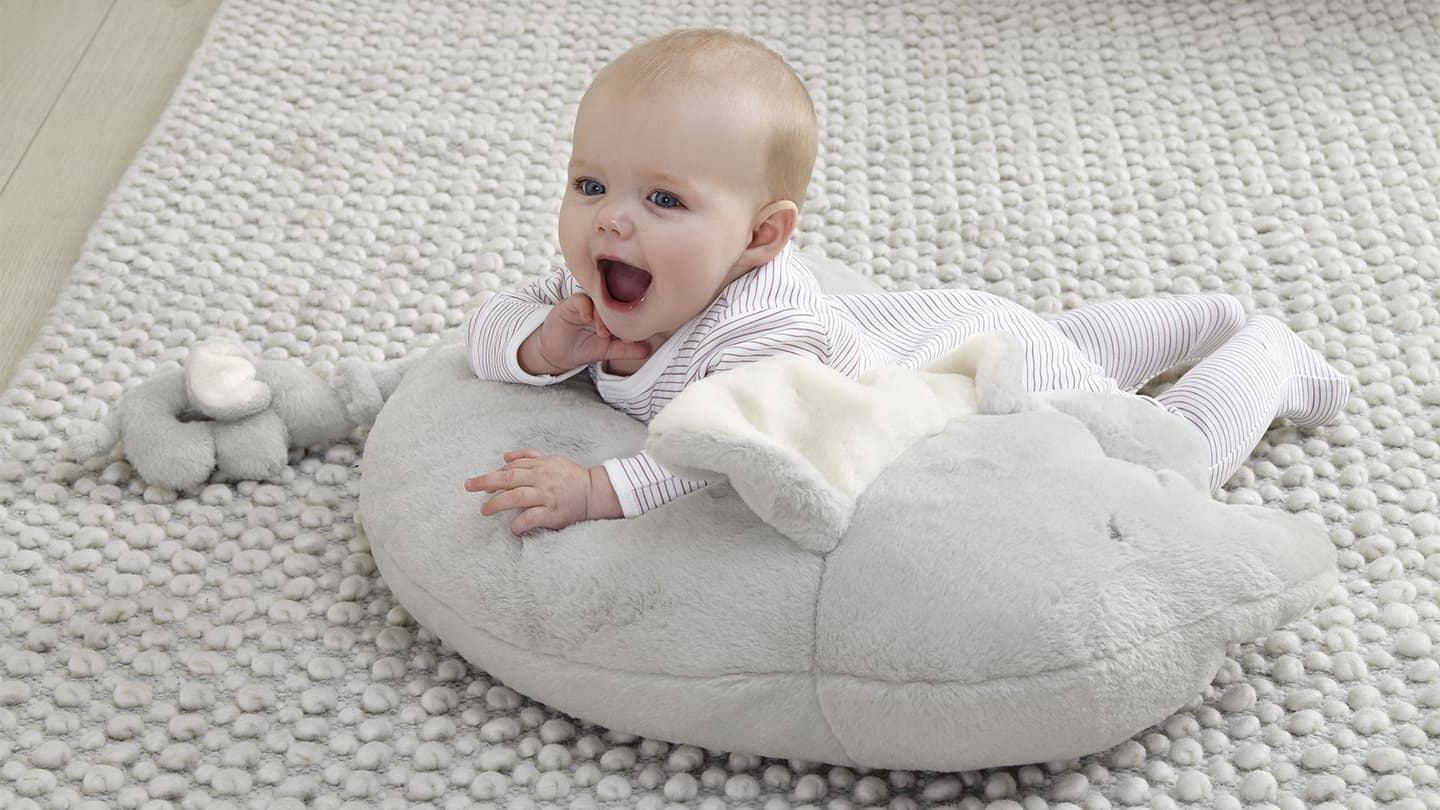In the first year of their life, a newborn baby has a lot of milestones to reach. From that first moment they stand, to the first steps they take. These don’t come magically, like anything they need a little time and practice. And exercise.
Tummy Time is widely regarded by healthcare professionals as one of the most important exercises your child can do. It will help to strengthen their muscles and improve their development. But what exactly is baby tummy time? What do you have to do? And how does Tummy Time help? Allow us to explain…
We spoke with health advisor, Moira, to get the lowdown on the benefits of tummy time.
What is Tummy Time?
Tummy Time is a series of exercises that require baby to be on their stomach, which help baby's mental and physical development, as they grow. As Moira explains: “Time on their backs meant that many babies were not engaging certain muscles, so Tummy Time would eventually help with developmental milestones like holding their head unsupported. Tummy Time is a way to redress this balance so that babies can still get necessary time on their front while awake.”
Why should my baby do Tummy Time and what are the benefits of Tummy Time?
The Health Advisor continues to describe, “Tummy Time is very important to encourage the motor development your needs for activities like sitting, rolling and crawling. It’s also an excellent position to prevent head flattening, as it relieves pressure from the back of their head. The muscles which lift the head are attached at the back and when they work, during Tummy Time, they can help to round out the lower part of the skull.”
The Tummy Time position is putting baby flat on their stomach. This way, a baby learns to take their weight through their arms, push up and move from side to side. All of which will help them to reach and crawl as they develop their motor skills. “As a baby gets stronger it provides a good position to learn to move and explore their surroundings… “ says Moira.
Another important aspect of newborn Tummy Time is that it helps with developing baby’s cognitive, thinking and reasoning. “When baby plays on their stomach, they are able to manipulate toys and play in their environment differently than they can when lying on their back. It gives them a different view of the world”.
When can my baby start Tummy Time?
Babies can start practising tummy time from day one but, as Moira explains: “Tummy Time activities should be dependent on baby’s age and temperament. For newborns in particular, activities should centre on carrying and calming baby.”
Can my premature baby do Tummy Time?
In short, yes. But make sure they are happy and comfortable. If they become irritated then stop. As with all newborns, in the early days it’s best to keep them close to you. Try laying baby face down on your chest while you lie back, or across your legs. “Another approach is the ‘tummy down carry’ or ‘football hold’; placing one hand under the baby’s tummy and between the legs, to carry them facing down.”
If your child is settled and calm then you can afford to try them on the floor, face down on a tummy time mat or blanket. You can even use a rolled-up towel or roller under their chest to raise them up. See below for some great Tummy Time accessories.
When is it best to do Tummy Time exercises?
You should only attempt Tummy Time when baby is happy, alert and awake. As the health advisor suggests, “It’s important to place baby on their tummy after routine activities such as nappy changing or bathing. Baby will begin to get used to Tummy Time as part of their daily routine… Also, it’s best if parents get down on the floor at baby’s eye level. Always supervise the baby during Tummy Time and never allow them to fall asleep on their tummy”.
How often should my baby do Tummy Time?
Moira says “Many sources suggest that parents should try to give their baby about 30 minutes of Tummy Time each day, using a variety of activities. This can be in a single episode or over several shorter periods throughout the day, increasing to 90 minutes as baby gets older.”
How can I monitor my child’s Tummy Time progress?
There are lots of helpful indicators to show that baby is developing as they should, but the key is to monitor baby's ability to move their head. Moira, a health advisor, has broken this down into what you can expect to see and when:
4 months: “By 4 months they should be able to move their head to both sides when lying on their back and can lift or hold their head, neck and chest upward when placed on their tummy.”
6 months: “By 6 months the baby should be able to roll from their back onto their tummy and reach for an object with both hands.”
9 months: “By 9 months baby should be able to sit independently with good balance, moving into a crawling position. They can reach to place toys into the palm of their hands and transfer between hands.”
12 months: “By 12 months, baby should be able to pull up to the standing position at furniture, and ‘cruise’, can walk with both hands held, they can take items out of a container and can use a ‘pincer grip’ to pick up small objects.”
What do I do if baby doesn’t like Tummy Time?
“If your baby doesn’t like being laid on the floor, start by giving them Tummy Time in your arms” says Moira. When baby gets used to being held that way, you can eventually introduce them to time on the floor. A little and often approach works best – for example, 10 lots of 6 minute Tummy Time sessions over the course of day.
When do you stop doing Tummy Time exercises?
There’s no set time frame, it really depends on how your baby takes to it. Once your little one learns how to roll over – or becomes more confident and independent in playing on their front as their motor skills have developed, you can reduce the time you dedicate to the Tummy Time exercises, as they will continue naturally.
What items can help with Tummy Time exercises?
Our dedicated range of baby Tummy Time toys are a great way to get your child playing on their front and having some Tummy Time fun. Here are just a couple:
1. Tummy Time Roll
These rounded pillows are a great way to support your little one during their exercises. Simply lay them over the Tummy Time cushion so it supports their arms and shoulders, whilst they enhance their head and neck control. The variety of hanging toys and interactive features like rattles, crinkles and mirrors will encourage them to reach out and play.
2. Rug and Roll
Our rug and roll combination toys give baby a variety of Tummy Time experiences. The soft rug lets you lay them out flat in those early days, and as they gain strength, the roll will help them to develop their upper body muscles and head control.
3. Playmats
Our tummy time playmats are a soft, safe way to lay baby down. The soft, padded base will cushion them from harder floors, while the arches keep them safe inside. With lots of interactive features, melodies and lights and hanging toys that are perfect for tummy time, they create a great environment for development.
4. Activity Toys
Our engaging activity tummy time toys work in a similar way to a tummy time roll, only by using playful characters like these soft toys. These soft animal toys are perfect for tummy time as it means your little one can enjoy cuddling up to their new favourite friend, while also building their muscle strength and coordination.
Hopefully our Tummy Time How To has given you some helpful Tummy Time tips and answers all your questions around Tummy Time exercises. If there’s anything you think we’ve missed, let us know. If it’s useful to you, it’s bound to be useful to someone else too.
And please remember, every child is different and develops at a slightly different speed. Don’t be down heartened if your child doesn’t reach certain milestones at specific times, as long as they’re showing signs of development, then it can only be a positive thing. If you do feel concerned though, contact your GP for advice on how best to encourage Tummy Time.













